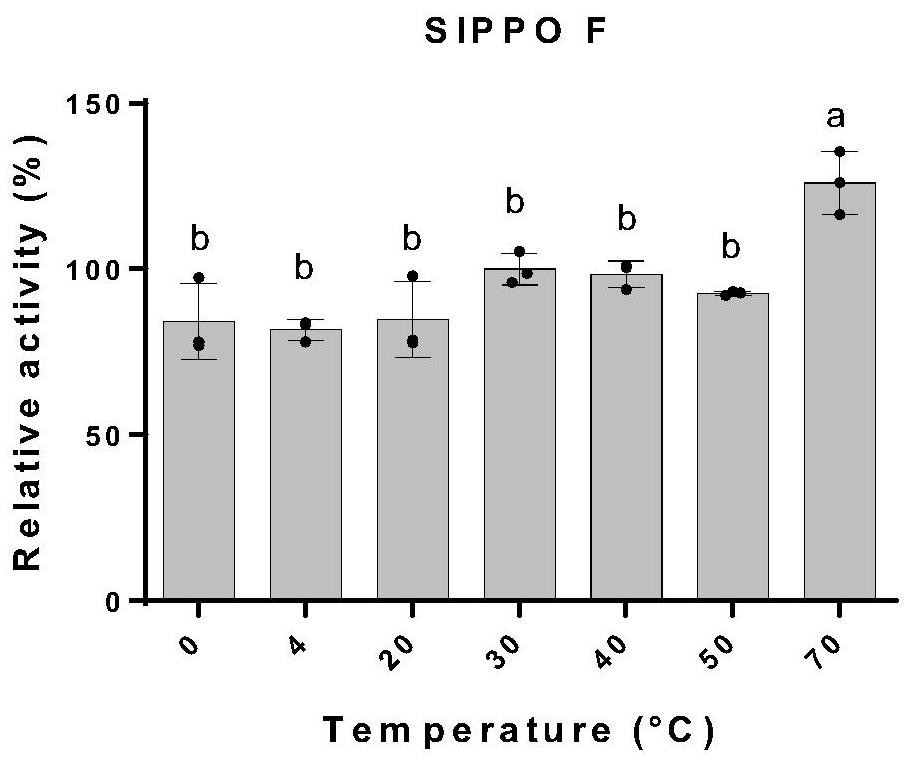Application of polyphenol oxidase and method for synthesizing flavone
A polyphenol oxidase and compound technology, applied in the biological field, can solve problems such as lack and achieve the effect of high thermal stability
- Summary
- Abstract
- Description
- Claims
- Application Information
AI Technical Summary
Problems solved by technology
Method used
Image
Examples
Embodiment 1
[0029] Embodiment 1, the cloning of tomato SlPPOs gene
[0030] (1) Extraction of tomato total RNA
[0031] The total RNA of tomato was extracted using the RNA kit of Chengdu Befit Technology Co., Ltd. The specific steps are as follows: transfer 40-100 mg of tomato fibrous roots into a 2 mL grinding tube, add steel balls with a diameter of 5 mm, close the lid and freeze in liquid nitrogen for 5 min, then Quickly transfer to a grinder for crushing; then immediately add solution A, vortex and mix well, briefly centrifuge for 5-10s, then add 300μL solution B and 200μL chloroform, vortex for 30s to fully emulsify the solution, room temperature, 12000g, centrifuge for 5min, Transfer 800 μL of supernatant to a new 2 mL centrifuge tube, add an equal volume of solution C, and immediately vortex to mix. Then transfer the above mixture into the RNA adsorption column twice, centrifuge at 12000g at room temperature for 1min, discard the waste liquid in the collection tube; add 700μL solu...
Embodiment 2
[0053] Embodiment 2, construct the Escherichia coli recombinant expression vector and engineering bacteria containing SlPPOs gene
[0054] The amplified SlPPOs gene (DNA sequence shown in SEQ ID NO.1-4) was connected to the vector pDONR207 through the BP reaction in the Gateway cloning technique, and the intermediate vectors obtained were named pDONR207-SlPPO A and pDONR207-SlPPO B respectively , pDONR207-SlPPO D, pDONR207-SlPPO F. Then Sangon Bioengineering (Shanghai) Co., Ltd. sequenced to confirm the correctness of the gene.
[0055] Then the intermediate vectors pDONR207-SlPPO A, pDONR207-SlPPO B, pDONR207-SlPPO D, pDONR207-SlPPO F were respectively connected with the expression vector pDEST17 using the LR reaction in Gateway cloning technology and transformed into Escherichia coli Trans10, positive clones were screened, and then the plasmid was extracted PCR detection was performed to obtain recombinant expression vectors containing four genes of SlPPO A, SlPPOB, SlPPPO ...
Embodiment 3
[0057] Embodiment 3, SlPPOs recombinant protein shows polyphenol oxidase and lyase activity
[0058] Induced expression of SlPPOs recombinant protein: the screened engineered bacteria BL21-pDEST17-SlPPO A / B / D / F were respectively cultured in 5 mL of LB liquid medium containing 50 mg / L Carb (carbenicillin) at 37 ° C and 200 rpm overnight, Then transfer it to 50 mL of the same LB liquid medium and shake it to OD 600 = 0.6-0.9. Then add IPTG (isopropylthio-β-D-galactoside) and CuSO to the bacterial solution 4 Make the final concentration 0.5mM; 20°C, 180rpm induction for 48h, room temperature, 5000g, 10min to collect the bacterial cells, which can be extracted immediately or frozen in -80°C refrigerator for later use.
[0059] Extraction and purification of SlPPOs recombinant protein: add 5mL lysis buffer (50mMNaH 2 PO 4 , 300mM NaCl, 10mM imidazole, pH 8.0), sonicate the bacterial cells (work 3s, interval 6s, 15min). After the bacterial cells were crushed, the supernatant wa...
PUM
 Login to View More
Login to View More Abstract
Description
Claims
Application Information
 Login to View More
Login to View More - R&D
- Intellectual Property
- Life Sciences
- Materials
- Tech Scout
- Unparalleled Data Quality
- Higher Quality Content
- 60% Fewer Hallucinations
Browse by: Latest US Patents, China's latest patents, Technical Efficacy Thesaurus, Application Domain, Technology Topic, Popular Technical Reports.
© 2025 PatSnap. All rights reserved.Legal|Privacy policy|Modern Slavery Act Transparency Statement|Sitemap|About US| Contact US: help@patsnap.com



